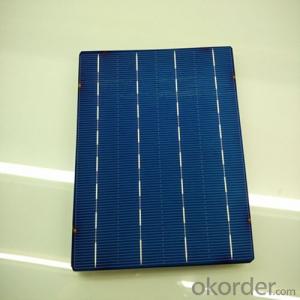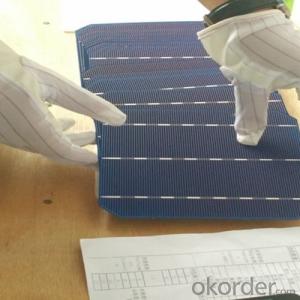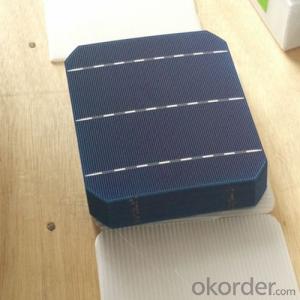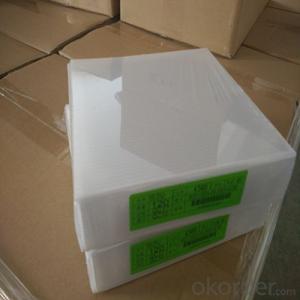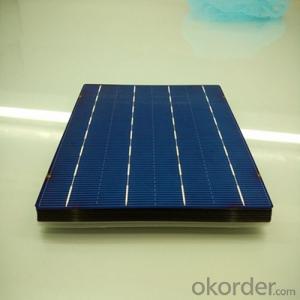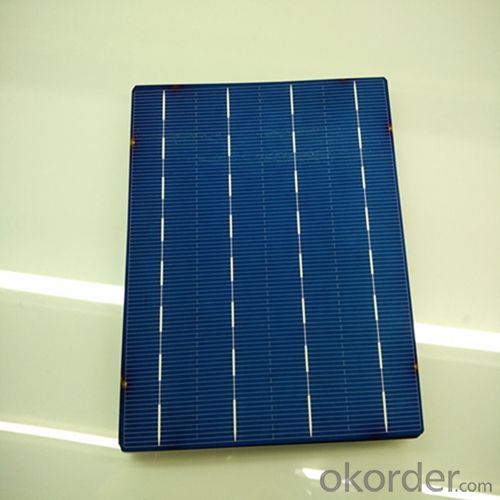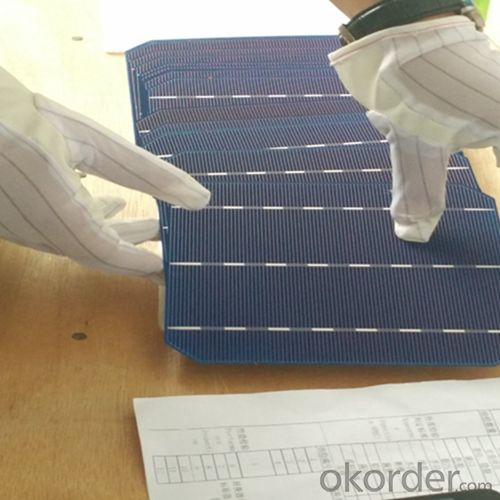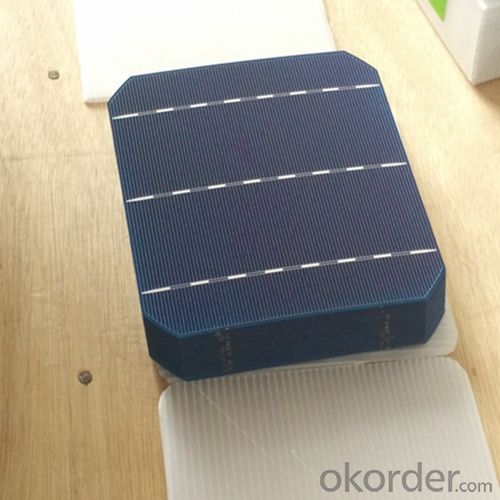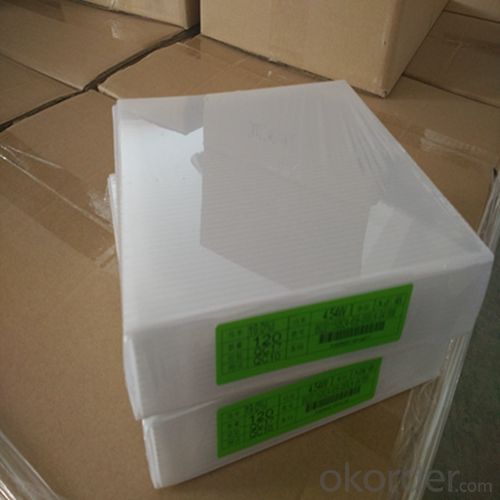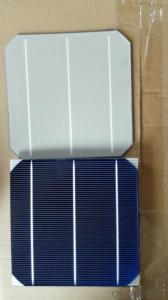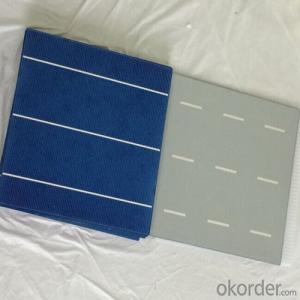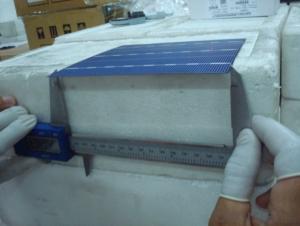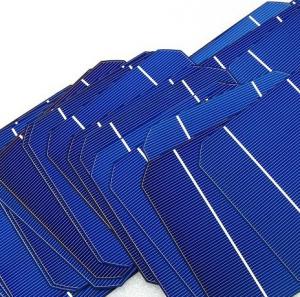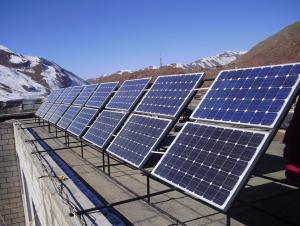Poly 156x156mm2 Solar Cells for Home Use - Class AA Quality
- Loading Port:
- Shanghai
- Payment Terms:
- TT OR LC
- Min Order Qty:
- 4600 watt
- Supply Capability:
- 6000000 watt/month
OKorder Service Pledge
OKorder Financial Service
You Might Also Like
The operation of a photovoltaic (PV) cell requires 3 basic attributes:
The absorption of light, generating either electron-hole pairs or excitons.
The separation of charge carriers of opposite types.
The separate extraction of those carriers to an external circuit.
In contrast, a solar thermal collector supplies heat by absorbing sunlight, for the purpose of either direct heating or indirect electrical power generation from heat. A "photoelectrolytic cell" (photoelectrochemical cell), on the other hand, refers either to a type of photovoltaic cell (like that developed by Edmond Becquerel and modern dye-sensitized solar cells), or to a device that splits water directly into hydrogen and oxygen using only solar illumination.Characteristic of Mono 156X156MM2 Solar Cells
You are gaining energy independence - add battery backup power for even greater energy security
The cost of electricity is only going to rise – insure against that rising cost
Adaptive cells change their absorption/reflection characteristics depending to respond to environmental conditions. An adaptive material responds to the intensity and angle of incident light. At the part of the cell where the light is most intense, the cell surface changes from reflective to adaptive, allowing the light to penetrate the cell. The other parts of the cell remain reflective increasing the retention of the absorbed light within the cell.[67]
In 2014 a system that combined an adaptive surface with a glass substrate that redirect the absorbed to a light absorber on the edges of the sheet. The system also included an array of fixed lenses/mirrors to concentrate light onto the adaptive surface. As the day continues, the concentrated light moves along the surface of the cell. That surface switches from reflective to adaptive when the light is most concentrated and back to reflective after the light moves along
Mechanical data and design
Format | 156mm x 156mm±0.5mm |
Thickness | 210μm±40μm |
Front(-) | 1.5mm bus bar (silver),blue anti-reflection coating (silicon nitride) |
Back (+) | 2.5mm wide soldering pads (sliver) back surface field (aluminium) |
Temperature Coefficient of Cells
Voc. Temp.coef.%/K | -0.35% |
Isc. Temp.coef .%/K | +0.024%/K |
Pm.Temp.coef. %/K | -0.47%/K |
Electrical Characteristic
Effiency(%) | Pmpp(W) | Umpp(V) | Impp(A) | Uoc(V) | Isc(A) | FF(%) |
18.35 | 4.384 | 0.526 | 8.333 | 0.63 | 8.877 | 78.39% |
18.20 | 4.349 | 0.526 | 8.263 | 0.63 | 8.789 | 78.54% |
18.05 | 4.313 | 0.525 | 8.216 | 0.63 | 8.741 | 78.32% |
17.90 | 4.277 | 0.524 | 8.161 | 0.625 | 8.713 | 78.04% |
17.75 | 4.241 | 0.523 | 8.116 | 0.625 | 8.678 | 77.70% |
17.60 | 4.206 | 0.521 | 8.073 | 0.625 | 8.657 | 77.36% |
17.45 | 4.170 | 0.519 | 8.039 | 0.625 | 8.633 | 76.92% |
17.30 | 4.134 | 0.517 | 8.004 | 0.625 | 8.622 | 76.59% |
17.15 | 4.096 | 0.516 | 7.938 | 0.625 | 8.537 | 76.80% |
17.00 | 4.062 | 0.512 | 7.933 | 0.625 | 8.531 | 76.18% |
16.75 | 4.002 | 0.511 | 7.828 | 0.625 | 8.499 | 75.34% |
16.50 | 3.940 | 0.510 | 7.731 | 0.625 | 8.484 | 74.36% |
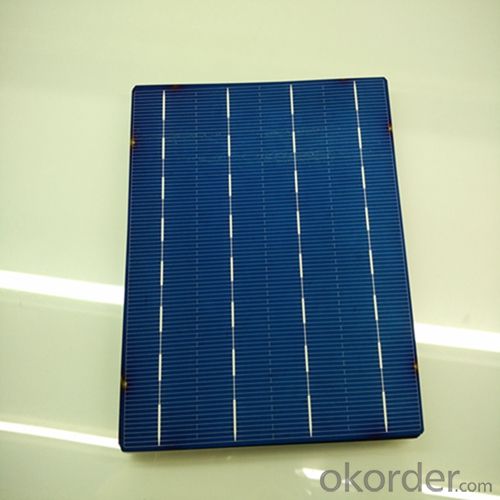
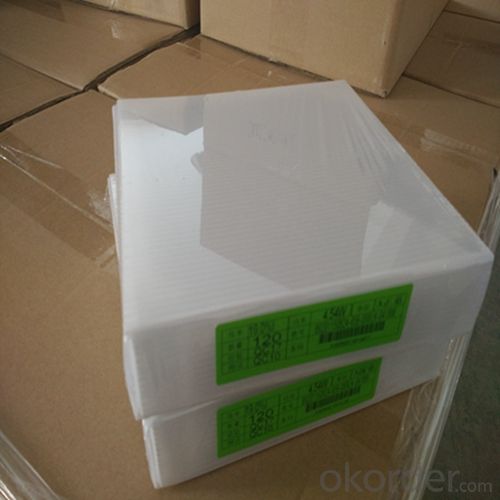
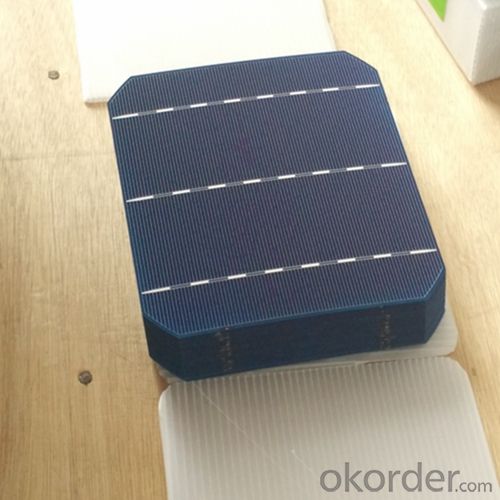
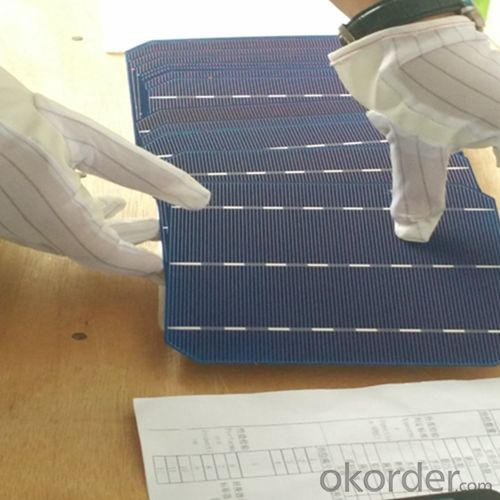
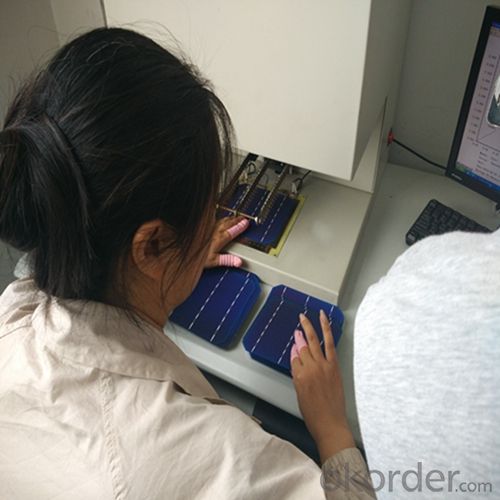 FAQ
FAQ
Q: What price for each watt?
A: It depends on the quantity, delivery date and payment terms, generally Large Quantity and Low Price
Q: What is your size for each module? Can you tell me the Parameter of your module?
A: We have different series of panels in different output, both c-Si and a-Si. Please take the specification sheet for your reference.
Q: What is your size for each module? Can you tell me the Parameter of your module?
A: We have different series of panels in different output, both c-Si and a-Si. Please take the specification sheet for your reference.
- Q: Can solar cells be used in combination with batteries?
- Yes, solar cells can be used in combination with batteries. The electricity generated by solar cells during the day can be stored in batteries for later use, allowing for a continuous supply of power even when the sun is not shining or during power outages. This combination is commonly used in solar energy systems to enhance their reliability and provide a sustainable source of electricity.
- Q: How do solar cells affect air pollution?
- Solar cells help reduce air pollution by generating clean, renewable energy from the sun. Unlike traditional fossil fuel power plants that release harmful pollutants like carbon dioxide, sulfur dioxide, and nitrogen oxides into the air, solar cells produce electricity without any emissions. By replacing fossil fuels with solar energy, we can decrease the amount of air pollution, mitigate climate change, and improve overall air quality.
- Q: Can solar cells be used to power emergency lighting systems?
- Yes, solar cells can be used to power emergency lighting systems. Solar cells convert sunlight into electricity, which can be stored in batteries for later use. In the event of a power outage, these solar-powered batteries can provide a reliable source of energy to power emergency lighting systems, ensuring safety and visibility during emergencies.
- Q: What kind of products can be considered as the solar cell products?
- Many products are actually solar cell product, such as solar air conditioning, solar balloon, solar charger, solar dryer, solar cooker, etc.
- Q: What is the cost of producing a solar cell?
- The cost of producing a solar cell can vary depending on various factors such as the type and quality of materials used, manufacturing processes, scale of production, and market conditions. However, advancements in technology and economies of scale have significantly reduced the cost of solar cell production over the years. On average, the cost of producing a solar cell can range from a few cents to a few dollars per watt.
- Q: Are solar cells affected by electromagnetic interference?
- Yes, solar cells can be affected by electromagnetic interference. Electromagnetic interference can degrade the performance of solar cells by disrupting the flow of electrons and causing fluctuations in output power. However, proper shielding and grounding techniques can be implemented to minimize these effects and ensure optimal functioning of solar cells.
- Q: How do solar cells perform in areas with high levels of chemical pollutants?
- Solar cells may not perform optimally in areas with high levels of chemical pollutants. The presence of pollutants in the air can reduce the amount of sunlight reaching the solar cells, thereby decreasing their efficiency and power output. Additionally, chemical pollutants may accumulate on the surface of the solar cells, leading to the formation of a layer that can block sunlight absorption. Regular cleaning and maintenance of the solar cells becomes crucial in such areas to mitigate the impact of chemical pollutants on their performance.
- Q: Can solar cells be used for powering irrigation systems?
- Yes, solar cells can be used to power irrigation systems. Solar panels can generate electricity from sunlight, which can then be used to power the pumps and other components of irrigation systems. This renewable energy source is environmentally friendly and can provide a reliable and sustainable solution for powering irrigation systems in remote areas or locations without access to conventional power sources.
- Q: Solar cells and the difference between ordinary batteries. Why is the solar cell is converted into electrical energy, zinc battery is what is converted into chemical energy
- The so-called chemical energy, in fact, is "chemical potential". Can be released through the oxidation-reduction reaction of energy, into other energy. This is the release of chemical energy.
- Q: Can solar cells be used in farming or agriculture?
- Yes, solar cells can be used in farming or agriculture. They can be employed to power various agricultural equipment, such as water pumps, lighting systems, and irrigation systems. Additionally, solar cells can be installed on the roofs of farm buildings or on open fields to generate electricity, which can be used to power farm operations or sold back to the grid. This allows farmers to reduce their reliance on traditional energy sources, lower their operating costs, and contribute to a more sustainable agricultural industry.
Send your message to us
Poly 156x156mm2 Solar Cells for Home Use - Class AA Quality
- Loading Port:
- Shanghai
- Payment Terms:
- TT OR LC
- Min Order Qty:
- 4600 watt
- Supply Capability:
- 6000000 watt/month
OKorder Service Pledge
OKorder Financial Service
Similar products
Hot products
Hot Searches
Related keywords
